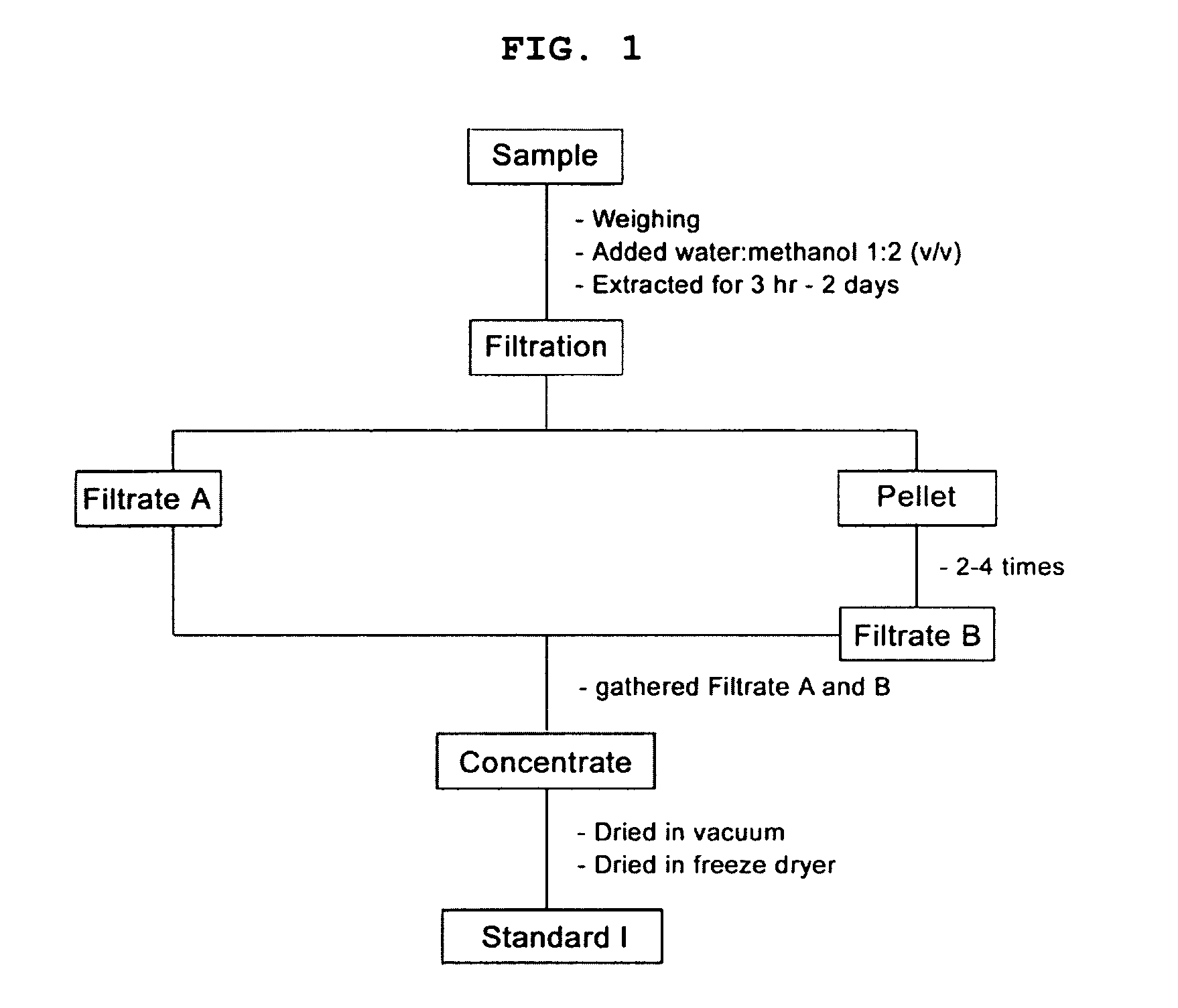Method for preventing plant diseases
a plant disease and method technology, applied in the field of plant diseases prevention, can solve the problems of difficult reliable prevention, increased use of chemical or organic pesticides, and rapid worsening of symptoms of powdery mildew
- Summary
- Abstract
- Description
- Claims
- Application Information
AI Technical Summary
Benefits of technology
Problems solved by technology
Method used
Image
Examples
example 1
Preparation of Anti-Pathogen Composition
[0066]Collected or purchased plant materials including Coptis Rhizoma (Coptis chinensis Franch.), Phellodendron amurense, Sanguinaria canadensis and Chelidonium majus var. asiaticum was dried in the shade, and then macerated with 20 mesh size. 100 g of the macerated plant materials were extracted with 500 ml distilled water or solvent consisting of water and ethanol (or methanol) with ratio of 2:1 in the extractor at room temperature for 24 hours and filtered. Crude extract was vacuum dried, and dried using freeze dryer (FIGS. 1 and 2). The freeze dried powder was defined as “standard extract”.
example 2
Antifungal Assay of the Anti-Pathogen Composition
[0067]For assessing antifungal activity of the standard extract prepared by Example 1, we performed antifungal assay against Colletrotrichum gloeosporiodes, Pythium ultimum, and Botrytis cinerea using the standard extract as follows: Crude extract was diluted serially to 1.6, 0.8, 0.4, 0.2 and 0.1 mg / l, and filter sterilized with membrane filter (0.2 μm, Gelman). We added 2 ml sterilized extracts to 18 ml of sterilized potato dextrose agar (PDA) medium and then let the PDA medium cool and harden. Plant pathogens described above were cultured in medium at 29° C. for 5 days. A small piece of fungal mass (5 m of diameter) of the pathogen was inoculated onto PDA medium and incubated at 29° C., for 4 days and then hyphal growth was measured. Through the assay relative growth inhibition rates (% GIR) was determined. The relative growth inhibition rate was calculated as follows:
[0068]100×{1—hyphal diameter of the standard extract-treated gro...
example 3
Isolation and Elucidation of Active Antifungal Compounds from Extract of 4 Plant Species and Analysis of Antimicrobial Activity of Derberine and Derivtives Thereof
[0070]The standard extract prepared by Example 1 and a berberine standard (Sigma, USA) were ran on TLC plate in solvent consising of chlroroform, methanol and H2O with the ratio of 5:1:0.1 and bands were detected by UV lamp. The TLC analysis was performed according to a known method. Among various bands of the standard extract, one corresponding to berberine standard and the other spot was separated by HPLC (FIG. 5). The HPLC condition indicated Table 2.
TABLE 2Condition of HPLC analysisParameterConditionColumnμBondpak C18Column(4.6 mm × 250 mm)Solvent system0.1% H3PO4 50%, CH3CN 50%, SDS 0.6%Flow rate1.5 ml / minDetectorUV visible 254 mmInjection volumeVolume 10 μL
[0071]HPLC analysis was performed by HPLC grade solvent and distilled water which was demineralized after by 0.45 μm filter. Other reagents for extracting and pre...
PUM
| Property | Measurement | Unit |
|---|---|---|
| concentration | aaaaa | aaaaa |
| concentration | aaaaa | aaaaa |
| pH | aaaaa | aaaaa |
Abstract
Description
Claims
Application Information
 Login to View More
Login to View More - R&D
- Intellectual Property
- Life Sciences
- Materials
- Tech Scout
- Unparalleled Data Quality
- Higher Quality Content
- 60% Fewer Hallucinations
Browse by: Latest US Patents, China's latest patents, Technical Efficacy Thesaurus, Application Domain, Technology Topic, Popular Technical Reports.
© 2025 PatSnap. All rights reserved.Legal|Privacy policy|Modern Slavery Act Transparency Statement|Sitemap|About US| Contact US: help@patsnap.com



